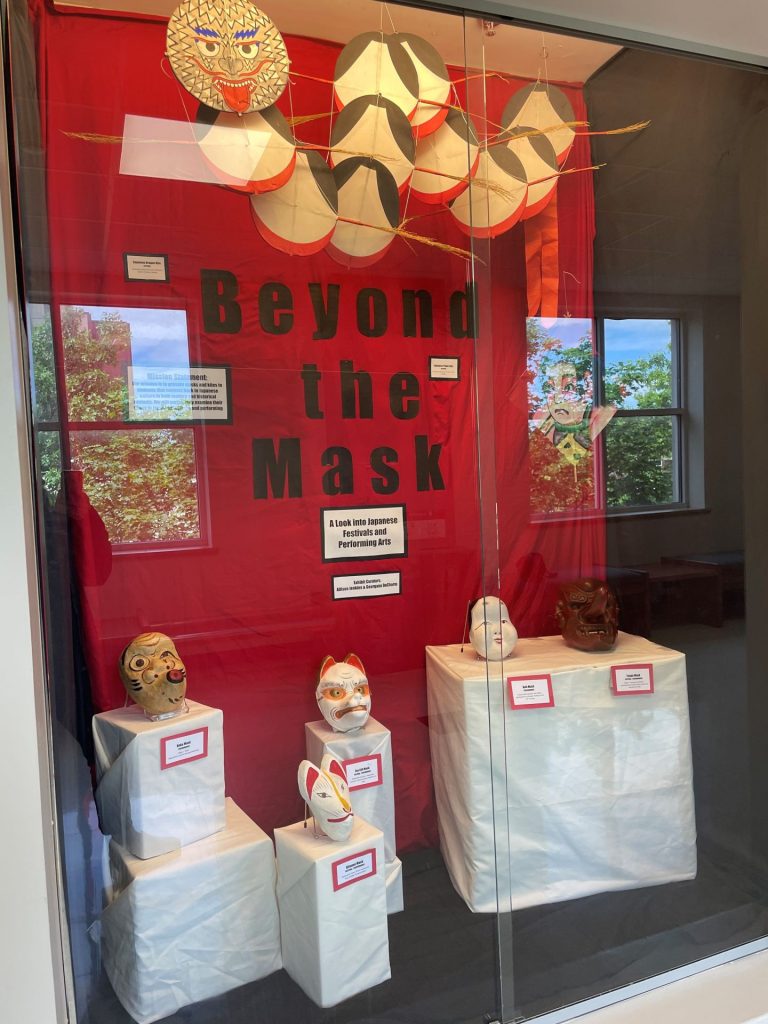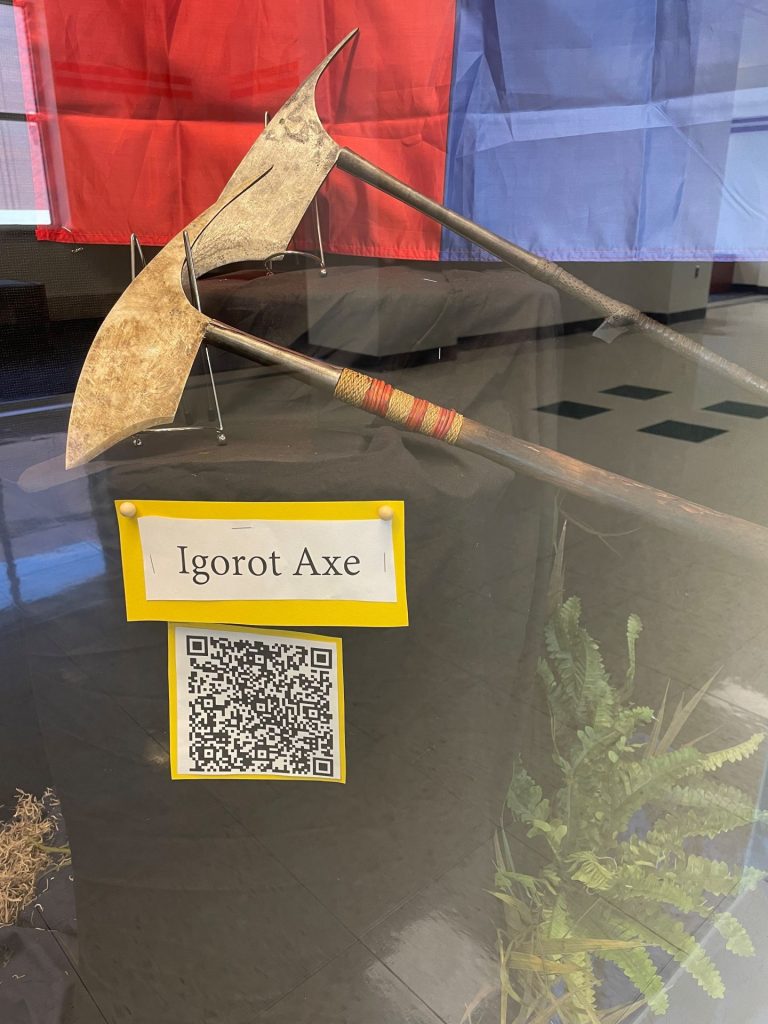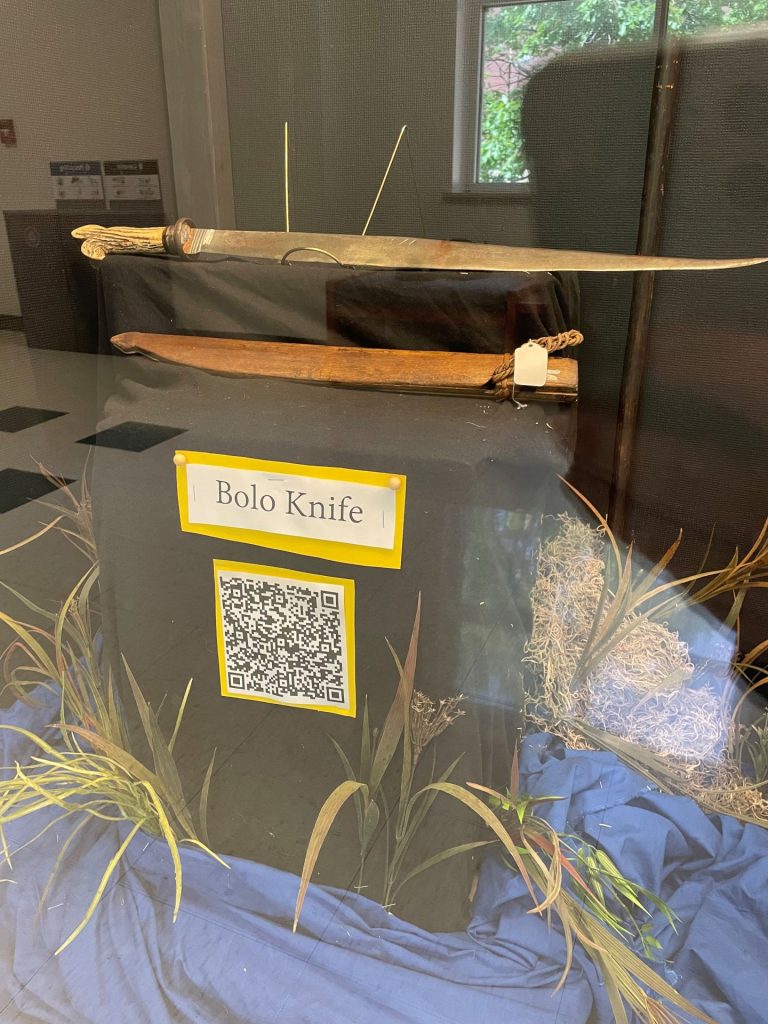Every spring, Dr. Kate Driscoll’s ANT 374 Museum Studies class examines the “history, organization, and administration of museums as well as the methods of acquisition, preservation and exhibition of artifacts.” In conjunction with their studies, the class designs a new cultural exhibit in the glass cases on the second floor of Schroeder Hall to showcase artifacts from different cultures across the globe. Showcasing pieces such as cross-cultural footwear and water bottles, these displays highlight both commonalities across different cultures as well as differences rooted in rich historical traditions unique to each region.

Schroeder Hall, West Wing exhibit space 
Schroeder Hall, West Wing exhibit space 
Schroeder Hall, West Wing Exhibit Space 
Schroeder Hall, West Wing Exhibit Space
Student exhibits
Footwear from the Philippines, Japan and Taiwan
By Britany Grashuis, Heather Paraday, and Jacob Hughes
This exhibit’s purpose is to show off a common article of clothing that everyone wears but takes focus into the history behind these regions and their traditional shoes. By showing the similarities and differences of these shoes, we hope to demonstrate the uses these shoes had culturally as well as possibly seeing how shoes have evolved. By taking these three countries and looking at shoes, we are able to see the shift in cultures and how they all play a direct impact on the other. While reviewing and researching the footwear, we focused on material, time period, and use. By comparing and contrasting the materials, time periods, and uses of these traditional footwear, we can also see how cultural influences have affected the development of footwear in these regions. Our hope is to allow those who see our exhibit to appreciate the cultural significance and unique histories of these everyday items.

Embroidered Dragon Slippers 
Wooden Geta Shoes and Japanese Rubber Sandals
Filipino weaponry
By Charles Roelant, Max Kirchhoff, and Zac Long
Picture in your mind a bladed metal weapon. Most likely, you pictured something like a sword, a spear or some kind of axe. What we as a society consider a “traditional” sword, spear, or axe has been greatly influenced by the designs that can be found on the European continent. From Dungeons and Dragons to a multitude of Hollywood movies weapons of this type are more familiar to us as they are our cultural norm. With our exhibit we wanted to highlight weapons that are familiar to the everyday viewer but unique enough to cause one to pause and notice the differences. For this reason we set about displaying these uniquely crafted weapons to broaden the perception as to what a weapon of war is.

Igorot Axe 
Bolo Knife
Worldwide writings
By Blaine Gilbert, Noah Virklan, and Alex Hanson
The world currently has a population of nearly 8 billion people who speak over 6,000 different languages and use several hundred distinct writing systems. Language is a defining characteristics of humanity, and writing is a primary mode of its preservation and study though time. Though writing is rarely considered so grand, it is worthy of attention and captivating to study. With this in mind, our exhibit displays examples of different writing systems from around the world and through the ages. Our exhibit showcases a Lipit-Istar Law Code Block replica showing Sumerian cuneiform, a door relief with examples of Egyptian hieroglyphics, a bamboo plate showing Chinese script, a Mayan Monument replica displaying Mayan glyphs, a Dharma doll box displaying Japanese script, and a hat box that shows examples of Burmese Abugida. We designed our exhibit in a minimalistic style to place emphasis on our chosen artifacts. We centered the display around a map to show geographic origins and added a timeline to reference periods of use and development. We also used color coordination to allow viewers to easily metabolize the information and to catch the eye. We think that writing is an important part of life and desire to foster interest in different writing systems. We enjoyed working on this exhibit and hope that viewers will enjoy learning about worldwide writings.

Egyptian Door Relief 
Chinese Bamboo Plate
Beyond the mask: A look into Japanese festivals and performing arts
By Georgana DuCharm and Allison Jenkins
Festivals have a deep-rooted history throughout Japanese culture. They recognize important deities, and they represent the changing of seasons and other events in Japanese history. Our goal through the exhibit, Beyond the Mask: A Look Into Japanese Festivals and Performing Arts, is to showcase artifacts that are important to Japanese festivals and performing arts as well as educate viewers about their importance in Japanese culture. Our hope is that everyone can enjoy the exhibit, from history lovers and anthropology students to students and professors walking through the halls of Schroeder. Next time you are walking down the halls on the second floor of Schroeder, make sure to stop by and take a look at our exhibit, Beyond the Mask: A Look Into Japanese Festivals and Performing Arts.
High quality H2O: An exhibit on cross cultural water bottles
By Katelyn Roderick and Jordan Buffington
A common item carried among ISU students on campus is a personal reusable water bottle, with multiple drinking fountains in Schroeder Hall that have attachments made for the refilling these bottles and even vending machines throughout the building which sell disposable bottles. The exhibit gives passersby a chance to glimpse the similarities and differences of how
others have thought and used items in ways so similar to ours using a display of objects from a variety of cultures and time periods from within the University’s teaching collection which all share the same common functions- the collection, carrying, and consumption of water. These water bottles on display are similar to the water bottles we use today, while also having
differences. The materials used to craft these water bottles vary, from the Filipino bamboo water collection tubes to the North American leather water pail, just like the ones we carry with us today, from stainless steel Yetis to plastic Camelbacks or the artistic and environmentally friendly glass bottles. The decorations on the exhibited objects also show similarities within the cross cultural collection and with the bottles used today. Here on campus, just like those of different cultures and time periods, we turn these functional containers into a form of artistic and individual expression using unique designs, be it decorative glazing for ceramic jars or vinyl stickers on plastic bottles. It is our hope that this exhibit provides fascinating insight to types of water containers used in generations passed, and how cultures created these functional forms of artistic expression using the materials readily available to
them, leaving those traveling the halls on the second floor of Schroeder with a lasting and thought provoking impressions in mind.

Animales de Arcilla
By Rebecca Groebe and Trinity Bair
In this exhibit, we explore different forms of animal clay sculpture from Costa Rica. Our goal is to encourage connection between the art and the real animals they are meant to represent. To aid our goal, we have provided context about the art styles used throughout Costa Rica. The inspiration for this exhibit came from both our own personal love for animals and the incredible strides the Costa Rican government has taken in the last 50 years to preserve and protect their natural areas and resources. In our exhibit “Animales de Arcilla,” we have displayed several different clay figures of animals that inhabit the water, land, and air. While enjoying the art, we want visitors to think about how they connect and interact with their own environment and the other beings within it. With an available translation in Spanish, we are excited to present the culmination of our work. The animals are waiting to see you!




